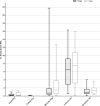Concentrations of macronutrients, minerals and heavy metals in home-prepared diets for adult dogs and cats
- PMID: 31506479
- PMCID: PMC6736975
- DOI: 10.1038/s41598-019-49087-z
Concentrations of macronutrients, minerals and heavy metals in home-prepared diets for adult dogs and cats
Abstract
Pet owners often don't acknowledge the need for home-prepared diet formulation by a trained professional and may use recipes from sources such as the internet. Macronutrient and mineral composition of home-prepared diets were analyzed and compared to NRC and FEDIAF recommendations, and heavy metal concentrations were analyzed and compared to FDA maximum tolerable levels (MTL) for dogs and cats. Recipes of home-prepared diets for adult dogs (n = 75) and cats (n = 25) were evaluated. Analyses of protein, fat, and fiber were performed according to AOAC, and mineral and heavy metal analyses were performed using inductively coupled plasma optical emission spectrometry (ICP-OES). None of the diets supplied recommended levels of all nutrients evaluated, and more than 84.0% of diets presented three or more nutrients below recommendations. Nutrients with most levels below recommendations were calcium and potassium in recipes for dogs and iron and zinc in recipes for cats. As for heavy metals, levels of lead, cobalt, mercury, uranium, and vanadium were above MTLs. Results suggest that home-prepared diets may be a health risk to dogs and cats if not properly formulated. Furthermore, the chronic heavy metal intake must be better elucidated in order to understand the full impact of results.
Conflict of interest statement
The authors declare no competing interests.
Figures



Similar articles
-
Toxic element levels in ingredients and commercial pet foods.Sci Rep. 2021 Oct 25;11(1):21007. doi: 10.1038/s41598-021-00467-4. Sci Rep. 2021. PMID: 34697366 Free PMC article.
-
Influence of number of ingredients, use of supplement and vegetarian or vegan preparation on the composition of homemade diets for dogs and cats.BMC Vet Res. 2021 Nov 20;17(1):358. doi: 10.1186/s12917-021-03068-5. BMC Vet Res. 2021. PMID: 34798889 Free PMC article.
-
Analysis of recipes of home-prepared diets for dogs and cats published in Portuguese.J Nutr Sci. 2017 Jul 3;6:e33. doi: 10.1017/jns.2017.31. eCollection 2017. J Nutr Sci. 2017. PMID: 29152237 Free PMC article.
-
The art of establishing mineral tolerances of dogs and cats.J Anim Sci. 2024 Jan 3;102:skae132. doi: 10.1093/jas/skae132. J Anim Sci. 2024. PMID: 38850274 Free PMC article. Review.
-
Focus on nutrition: Home-prepared diets for dogs and cats.Compend Contin Educ Vet. 2013 Mar;35(3):E3. Compend Contin Educ Vet. 2013. PMID: 23532921 Review.
Cited by
-
Zinc Concentration in Blood Serum of Healthy Dogs.Biol Trace Elem Res. 2023 Jul;201(7):3356-3366. doi: 10.1007/s12011-022-03441-x. Epub 2022 Oct 13. Biol Trace Elem Res. 2023. PMID: 36224317
-
Nutritional Evaluation and Risk Assessment of the Exposure to Essential and Toxic Elements in Dogs and Cats through the Consumption of Pelleted Dry Food: How Important Is the Quality of the Feed?Toxics. 2021 Jun 5;9(6):133. doi: 10.3390/toxics9060133. Toxics. 2021. PMID: 34198811 Free PMC article.
-
Diet and dog characteristics affect major and trace elements in hair and blood of healthy dogs.Vet Res Commun. 2022 Feb;46(1):261-275. doi: 10.1007/s11259-021-09854-8. Epub 2021 Nov 6. Vet Res Commun. 2022. PMID: 34741715 Free PMC article.
-
Toxic element levels in ingredients and commercial pet foods.Sci Rep. 2021 Oct 25;11(1):21007. doi: 10.1038/s41598-021-00467-4. Sci Rep. 2021. PMID: 34697366 Free PMC article.
-
Clinical health markers in dogs fed raw meat-based or commercial extruded kibble diets.J Anim Sci. 2021 Jun 1;99(6):skab133. doi: 10.1093/jas/skab133. J Anim Sci. 2021. PMID: 33939804 Free PMC article.
References
-
- NRC. Nutrient Requirements of Dogs and Cats. (National Academy Press, 2006).
-
- FEDIAF. Nutritional Guidelines for Complete and Complementary Pet Food for Cats and Dogs. (Fédération Européenne de l’Industrie des Aliments pour Animaux Familiers, 2018).
-
- Freeman L, et al. Nutritional Assessment Guidelines. J. Small Anim. Pract. 2011;82:254–263. - PubMed
-
- Thatcher, C. D., Hand, M. S. & Remillard, R. L. Small animal clinical nutrition: an iterative process. in Small Animal Clinical Nutrition (eds Hand, M. S., Thatcher, C. D., Remillard, R. L., Roudebush, P. & Novotny, B. J.) 3–20 (Mark Morris Institute, 2010).
-
- Gross, K. L. et al. Macronutrients. In Small Animal Clinical Nutrition (eds. Hand, M. S., Thatcher, C. D., Remillard, R. L., Roudebush, P. & Novotny, B. J.) 49–105 (Mark Morris Institute, 2010).
MeSH terms
Substances
LinkOut - more resources
Full Text Sources
Medical
Research Materials
Miscellaneous

